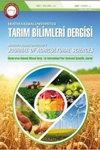不同产地苜蓿品种产量与饲料品质的变异及相关性
IF 1.1
4区 农林科学
Tarim Bilimleri Dergisi-journal of Agricultural Sciences
Pub Date : 2017-03-14
DOI:10.15832/tbd.07864
引用次数: 13
摘要
苜蓿是我国最重要的饲料植物。世界上有许多苜蓿品种具有提高产量和饲料质量的潜力。他们中的许多人也在东南欧地区使用各种育种技术被创造出来。这项调查是在塞尔维亚中部进行的,包括15个不同产地的苜蓿品种(9个来自美国,6个来自欧洲)。目的是确定它们在开采第二年(A1)和第三年(A2)的每片产量和总干物质产量(TDMY),以及饲料品质:矿物物质(MM)、粗蛋白质(CP)、粗纤维(CF)、粗脂肪(CFM)和无氮浸出物(NFE)的含量。研究品种干物质产量(DMY)的总变异率较高(A1: CV= 13.19%;A2: cv = 9.33%)。美国品种的DMY变异率较高(A1: CV= 13.65%;A2: CV= 9.92%)高于欧洲(A1: CV= 6.67%;A2: cv = 8.01%)。美国品种的粗蛋白质含量差异也大于欧洲品种(CV分别为6.27%和2.68%)。不同品种(基因型)间的差异也影响了牧草品质参数的总变异率,CP的总变异系数在5.07% ~ 10.48%之间,干物质产量(DMY)与CP (r= 0.344)、CF (r= 0.342)和CFM (r= 0.306)呈显著正相关,而CF和NFE之间的相关性最强(r= -0.917)。本文章由计算机程序翻译,如有差异,请以英文原文为准。
Variability and Correlation of Yield and Forage Quality in Alfalfa Varieties of Different Origin
Alfalfa is the most important forage plant species. There are numerous alfalfa varieties in the world with improved yield potential and forage quality. Many of them have also been created in the region of Southeast Europe, using various breeding techniques. This investigation was carried out in central Serbia and it included 15 alfalfa varieties of different origin (nine from USA and six from Europe). The objective was to determine their yield in each cut and total dry matter yield (TDMY) in the second (A1) and third (A2) year of exploitation, as well as forage quality: the content of mineral matter (MM), crude protein (CP), crude fiber (CF), crude fat matter (CFM) and nitrogen-free extract (NFE). Investigated varieties exhibited high total variability in dry matter yield (DMY) (A1: CV= 13.19%; A2: CV= 9.33%). DMY variability was higher with the varieties from USA (A1: CV= 13.65%; A2: CV= 9.92%) than with those from Europe (A1: CV= 6.67%; A2: CV= 8.01%). Varieties from USA also proved more variable in crude protein (CP) content than European varieties (CV= 6.27% and CV= 2.68%, respectively). Differences between the investigated varieties (genotypes) also influenced total variability of forage quality parameters, with total CV ranging from 5.07% for CP to 10.48% for CF. Dry matter yield (DMY) had significant positive correlation with CP (r= 0.344), CF (r= 0.342) and CFM (r= 0.306), and the strongest correlation, although negative, was between CF and NFE (r= -0.917).
求助全文
通过发布文献求助,成功后即可免费获取论文全文。
去求助
来源期刊
CiteScore
1.40
自引率
0.00%
发文量
26
期刊介绍:
Journal of Agricultural Sciences (JAS) is an international, double-blind peer-reviewed, open-access journal, published by the Faculty of Agriculture, Ankara University. The journal invites original research papers containing new insight into any aspect of Agricultural Sciences that are not published or not being considered for publication elsewhere. Preliminary, confirmatory or inconclusive research, review articles, case and local studies and works presenting taxonomy will not be published.

 求助内容:
求助内容: 应助结果提醒方式:
应助结果提醒方式:


